We'll be at the National Book Festival tomorrow. Rain or shine! I hope it shines, though.

Your Custom Text Here
We'll be at the National Book Festival tomorrow. Rain or shine! I hope it shines, though.

 I'm rereading Little Women for my neighborhood book club (we're reading it together with March by Geraldine Brooks). I must have been younger than Amy when I first read Little Women; I've reread it (or parts of it) countless times since then. It's like an old friend to me.
I'm rereading Little Women for my neighborhood book club (we're reading it together with March by Geraldine Brooks). I must have been younger than Amy when I first read Little Women; I've reread it (or parts of it) countless times since then. It's like an old friend to me.
That said, I had forgotten how irritating Amy's malapropisms can be. They start on p.3 with "label" for "libel" and don't stop until Amy goes abroad (at least I hope they stop by then. I haven't gotten that far yet). She's the literary forerunner of Junie B. Jones, for goodness' snake! And all the other fictional children who too-frequently mistake one word for another (Clementine, I'm talking to you). As far as I'm concerned, it's only funny when my kids do it. Not to worry, though: I won't quote them here.

I suppose I should be pleased that the cat in Caroline Lazo's charming picture book Someday When My Cat Can Talk (illustrated by Kyrsten Brooker; Schwartz and Wade, 2008) made it to Spain on his European adventure at all. But here's what he has to say about it:
He'll talk about events in Spain--
like bullfights every spring.
And he'll praise himself for stopping one
by jumping in the ring.
At the back of the book, Lazo notes that "[b]ullfighting is Spain's best known and most-unusual spectacle, but today many people think it is cruel to kill bulls--or any animals--for sport, and hope it will end soon." While I'm not accusing Lazo of perpetuating the leyenda negra in picture book form, I'm disappointed that she chose bullfighting to represent Spain. No other country is represented negatively. Next time, may I suggest that the cat make a pilgrimage to Santiago de Compostela, read Don Quijote, dance flamenco or visit the Alhambra instead?
[Disclaimer: No bulls were harmed in the writing of this post. And the Poetry Friday roundup is at author amok. Thanks!]
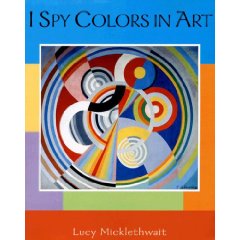
We've been enjoying the latest in the series of "I Spy" art books by Lucy Mickelthwait, I Spy Colors in Art (Greenwillow, 2007). The concept is simple and elegant: pair an "I Spy" statement ("I spy with my little eye an orange orange") with a painting (John Frederick Peto, The Poor Man's Store) on the facing page. You can extend it all sorts of ways, too: after she finds what I'm spying, Milly asks me to look for something else in each painting; or we'll make up a story about what might happen next. All the while, the kids (Leo likes to play, too) are familiarizing themselves with fine art and figuring out how to join the conversation about it.
Milly had a lot to say on Saturday at the Smithsonian American Art Museum. We were just trying to escape from the heat at the Arts on Foot festival, but her interest in looking at and talking about particular paintings reminded me that we haven't visited the National Gallery with her, either. At least not since she could talk. We're already planning to visit later this month.
Of course, a visit to the art museum should always end at the museum gift shop, where you can purchase for small change a postcard of the painting (or whatever) you liked best. I have a small collection of museum postcards that tends toward paintings of mothers and daughters; women reading, writing, or doing needlework; 15th c. portraits and Dutch interiors. As Milly starts her own collection of art cards, I'm considering mounting them in a series of simple staple-bound books so we can play "I spy" with paintings that mean something special to her.
[I spy the Nonfiction Monday roundup at Picture Book of the Day!]
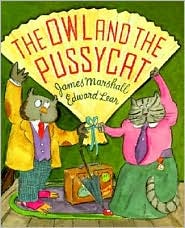 My favorite picture book edition of Edward Lear's The Owl and the Pussycat is, not suprisingly, James Marshall's. I love that the "beautiful pea-green boat" is a cruise ship, the S.S. Dorabella. The watercolor sketches for this book were Marshall's last work.
My favorite picture book edition of Edward Lear's The Owl and the Pussycat is, not suprisingly, James Marshall's. I love that the "beautiful pea-green boat" is a cruise ship, the S.S. Dorabella. The watercolor sketches for this book were Marshall's last work.
Lear himself did not finish "The Children of the Owl and the Pussycat," portions of which were published posthumously. Here are the opening lines:
Our mother was the Pussycat,
our father was the Owl,
And so we're partly little beasts
and partly little fowl.
The brothers of our family
have feathers and they hoot,
While all the sisters dress in fur
and have long tails to boot.
We all believe that little mice,
For food are singularly nice.
I love narrative poetry for children, like "Wynken, Blynken, and Nod" (Eugene Field) and "The Owl and the Pussycat" (Edward Lear). Also for grownups: "The Highwayman" (Alfred Noyes; thank you, Charlotte) and "The Farmer's Bride" (Charlotte Mew). The latter was the Poem of the Week on the Guardian Books blog this week (thank you, Carol Rumens); like "The Highwayman," it is a dark and lovely love poem.
The Farmer's Bride
Three summers since I chose a maid,
Too young maybe - but more's to do
At harvest-time than bide and woo.
When us was wed she turned afraid
Of love and me and all things human;
Like the shut of a winter's day.
Her smile went out, and t'wasn't a woman -
More like a little frightened fay.
One night, in the Fall, she runned away.
"Out 'mong the sheep, her be," they said,
'Should properly have been abed;
But sure enough she wasn't there
Lying awake with her wide brown stare.
So over seven-acre field and up-along across the down
We chased her, flying like a hare
Before our lanterns. To Church-Town
All in a shiver and a scare
We caught her, fetched her home at last
And turned the key upon her, fast.
[Read the rest here.]
[The Poetry Friday round-up is at Wild Rose Reader this week. Thank you, Elaine!]

Carolyn See reviewed Ms. Hempel Chronicles by Sarah Shun-Lien Bynum (Harcourt, 2008) in the Washington Post today (9/5/2008). It's a book for adults, a series of interconnected stories (one of my favorite forms) about a middle school English teacher who actually likes her students. There's more, of course--Ms. Hempel is new to teaching; new even to her own, grownup life: according to See, she's "doing her best to fake her way into the adult community" (sometimes I feel as if I'm still doing this myself, and I'm 36).
I'm particularly interested in how this newness plays out in the classroom. See gives one example: "She assigns Tobias Wolff's This Boy's Life to her seventh-graders, and when a proverbial pill of a mother objects to the strong language on Parents' Night, Ms. Hempel stands up for truth and authenticity in literaure and, unexpectedly, wins the day." Maybe she should have assigned Old School? At any rate, (the?) Ms. Hempel Chronicles is on my to-read list.
I should note that the cover is gorgeous, too.

I finally found a bike with a basket big enough to hold my library books. Bakfiets!
 The most endearing detail of Axel Scheffler's art for The Gruffalo's Child by Julia Donaldson (Dial Books for Young Readers, 2005) is the stick doll that she carries thoughout the book. You can see her clutching it on the cover. The year The Gruffalo's Child came out, I made Leo a small stuffed gruffalo, complete with stick doll, and gave it to him together with the book for Christmas (believe me, it was much easier to make than the gruffalo costume he wanted for Halloween that year would have been). The stick doll has since been lost, but I suspect we will be making more once we read Donaldson and Scheffler's latest book: Stick Man. It's available now in the UK (Leo, as a member of The Gruffalo Gang, heard about it first).
The most endearing detail of Axel Scheffler's art for The Gruffalo's Child by Julia Donaldson (Dial Books for Young Readers, 2005) is the stick doll that she carries thoughout the book. You can see her clutching it on the cover. The year The Gruffalo's Child came out, I made Leo a small stuffed gruffalo, complete with stick doll, and gave it to him together with the book for Christmas (believe me, it was much easier to make than the gruffalo costume he wanted for Halloween that year would have been). The stick doll has since been lost, but I suspect we will be making more once we read Donaldson and Scheffler's latest book: Stick Man. It's available now in the UK (Leo, as a member of The Gruffalo Gang, heard about it first).
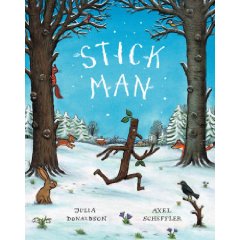 I wonder whether Donaldson and Scheffler collaborated at all on this new book? The text of The Gruffalo's Child doesn't say anything about the stick doll (there are some stick animals, too), so I assume that was originally Scheffler's idea, and Donaldson ran with it. At any rate, the kids and I love Donaldson and Scheffler's work, and it seems that kids and parents in Great Britain do, too: two of their books (The Gruffalo and Room on the Broom) made this top ten list of Britain's favorite bedtime stories (scroll down; from The Scotsman, 9/4/2008). Check out The Snail and the Whale, too: highly recommended.
I wonder whether Donaldson and Scheffler collaborated at all on this new book? The text of The Gruffalo's Child doesn't say anything about the stick doll (there are some stick animals, too), so I assume that was originally Scheffler's idea, and Donaldson ran with it. At any rate, the kids and I love Donaldson and Scheffler's work, and it seems that kids and parents in Great Britain do, too: two of their books (The Gruffalo and Room on the Broom) made this top ten list of Britain's favorite bedtime stories (scroll down; from The Scotsman, 9/4/2008). Check out The Snail and the Whale, too: highly recommended.
[N.b., at our house we pronounce it GROO-ffa-lo. Don't you?]
[Books that Cook: An occasional feature in which the Books Together Test Kitchen (that would be me and my kids) prepares a recipe from the back of a picture book. In this case, the recipe is actually in the middle of the picture book, which is a little inconvenient but still delicious.]
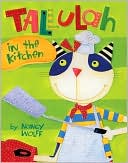 We had our traditional first-day-of-school pancake breakfast this morning. If you're a regular reader of bookstogether, you may remember that we like our pancakes! I usually use Trader Joe's Multigrain Baking Mix, which makes something resembling pancakes only healthier, on weekday mornings; but this morning we tested the recipe for Tallulah's Amazing Blueberryalicious Pancakes from Tallulah in the Kitchen by Nancy Wolff (Henry Holt, 2005).
We had our traditional first-day-of-school pancake breakfast this morning. If you're a regular reader of bookstogether, you may remember that we like our pancakes! I usually use Trader Joe's Multigrain Baking Mix, which makes something resembling pancakes only healthier, on weekday mornings; but this morning we tested the recipe for Tallulah's Amazing Blueberryalicious Pancakes from Tallulah in the Kitchen by Nancy Wolff (Henry Holt, 2005).
Notes from the Test Kitchen


When the Wolves Returned: Restoring Nature's Balance in Yellowstone by Dorothy Hinshaw Patent; photographs by Dan Hartman and Cassie Hartman (Walker, 2008).
The Wolves Are Back by Jean Craighead George; paintings by Wendell Minor (Dutton, 2008).
These two nonfiction picture books cover the same topic in very different, equally effective ways. We have a soft spot for wolves; so we read both of them.
When the Wolves Returned is illustrated with historical and contemporary photographs of the park, its human visitors and its wild inhabitants. Patent's text is dual-level: one sentence in large type on the left hand page, a more detailed paragraph in smaller type on the right. Back matter includes a note about the photographs, a bibliography, and an index; there is also a diagram of "The Wolf Effect" that tests your memory of how the wolves' return has impacted other plants and animals at Yellowstone.
The Wolves Are Back is illustrated with Wendell Minor's realistic watercolor-and-gouache paintings. George's text tells the story of Yellowstone's wolves in the context of one wolf pup's adventures (not surprisingly; George is a novelist, author of the Newbery Award-winning Julie of the Wolves); it is more poetic, punctuated by the refrain "The wolves are back." There is no back matter apart from the artist's list of sources.
I think these two books--these two types of books--are complements rather than substitutes. I was interested in which type of book appealed most to which of my kids (I had some ideas, although they both generally prefer fiction to nonfiction read-alouds); but there was no comparison: the kids saw them as two different, equally appealing books.
[The Nonfiction Monday round-up is at Picture Book of the Day. Thanks, Anastasia!]

From this week's PW Children's Bookshelf (8/28/2008):
"James Marshall, who created more than 75 books for children, died on October 13, 1992, nearly 16 years ago, at the age of 50. His passing left a hole in the hearts of those who knew him and worked with him, as well as his innumerable fans. This September, Houghton Mifflin is reissuing all 35 of Marshall’s beloved George and Martha stories in one omnibus edition; several authors and artists were invited to write appreciations for the book, and we include a selection of them here."
I absolutely adore George and Martha (I know; doesn't everyone?). And even though (or maybe because) I already own most of the George and Martha books, in various editions (book club) and conditions (ex-lib), I think I need the omnibus, too.
[In other hippo news, the Washington Post recently reported that the National Zoo is looking for a new home for its hippo, Happy ("Zoo's Hippo Must Hit the Road," 8/3/08). The kids drew hippo pictures (obviously inspired by James Marshall) and sent them to the hippo's keeper, JT. We'll miss you, Happy.]
 From last week's PW Children's Bookshelf (8/21/08):
From last week's PW Children's Bookshelf (8/21/08):
"Noel Streatfeild's 1936 novel Ballet Shoes, which was adapted by the BBC and shown in Britain earlier this year, has been picked up by Screenvision to be shown in U.S. theaters, according to Variety. The feature-length film reunites three actors from the Harry Potter movies: Emma Watson (Hermione Granger), Richard Griffiths (Vernon Dursley) and Gemma Jones (Poppy Pomfrey). Limited release begins August 26, and a DVD will follow."
Emma Watson plays Pauline. The movie is playing in two local theaters, but I think I'll wait for its release on DVD next week (9/2/08), if only because I can't find anyone who'll see it with me. Actually, I'm not at all sure that I'll like it. Unlike The Golden Compass, Ballet Shoes (the book) was a childhood favorite, my favorite of all the Shoes books I read. Sometimes I liked Posy best, sometimes prickly Petrova, but eventually I grew to appreciate (if not identify with) pretty actress Pauline.
 I was also delighted to discover that there are Shoes books I haven't read! This website is an excellent source of information about, and analysis of Noel Streatfeild's books for children (and adults). Many of them are hard to find now, and I'm sadly missing my childhood copy of Skating Shoes (my next favorite; used copies of the Dell Yearling paperback I had are available on Amazon starting at $43.45). But Oxford Children's Classics has a beautiful new edition of Party Shoes that I'd love to get my hands on. In the meantime, I'll just have to get out my worn-out copy of Ballet Shoes.
I was also delighted to discover that there are Shoes books I haven't read! This website is an excellent source of information about, and analysis of Noel Streatfeild's books for children (and adults). Many of them are hard to find now, and I'm sadly missing my childhood copy of Skating Shoes (my next favorite; used copies of the Dell Yearling paperback I had are available on Amazon starting at $43.45). But Oxford Children's Classics has a beautiful new edition of Party Shoes that I'd love to get my hands on. In the meantime, I'll just have to get out my worn-out copy of Ballet Shoes.
What are your favorite Shoes?
 We were on vacation in Miami Beach for the last two weeks. The first week the weather was gorgeous. After a day of playing in the white sand and clear blue water, the kids and I would clean up and go out to the wide tiled terrace overlooking the ocean, to sort through the day's collection of seashells and sit on deck chairs reading Pippi in the South Seas (this image is of my childhood copy, illustrated by Louis S. Glanzman; Puffin, 1977). I think this is my favorite Pippi book, and the chapters that take place on board the Hoptoad (Pippi's father's ship) and on Kurrekurredutt Island made perfect on-location reading.
We were on vacation in Miami Beach for the last two weeks. The first week the weather was gorgeous. After a day of playing in the white sand and clear blue water, the kids and I would clean up and go out to the wide tiled terrace overlooking the ocean, to sort through the day's collection of seashells and sit on deck chairs reading Pippi in the South Seas (this image is of my childhood copy, illustrated by Louis S. Glanzman; Puffin, 1977). I think this is my favorite Pippi book, and the chapters that take place on board the Hoptoad (Pippi's father's ship) and on Kurrekurredutt Island made perfect on-location reading.
Pippi and Tommy and Annika set off for home before the start of the rainy season. We mistimed our departure, and it rained for most of the second week of our vacation [see Tropical Storm Fay]. Now reporting from Arlington, VA: we're home.
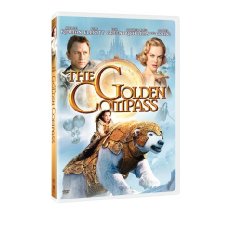 My husband and I watched The Golden Compass last weekend. Disclaimer: I'm not a scholar of Philip Pullman's His Dark Materials. I read The Golden Compass and liked it well enough; I started The Subtle Knife and abandoned it (if I recall correctly, its agenda was too obvious); I never bothered with The Amber Spyglass. I didn't have high expectations for the movie version of Compass, either, all of which may explain why I liked it as much as I did (and more than the first Narnia movie). I'm actually disappointed that the sequels to the movie will probably never be made.
My husband and I watched The Golden Compass last weekend. Disclaimer: I'm not a scholar of Philip Pullman's His Dark Materials. I read The Golden Compass and liked it well enough; I started The Subtle Knife and abandoned it (if I recall correctly, its agenda was too obvious); I never bothered with The Amber Spyglass. I didn't have high expectations for the movie version of Compass, either, all of which may explain why I liked it as much as I did (and more than the first Narnia movie). I'm actually disappointed that the sequels to the movie will probably never be made.
Here's what I liked:
Have you seen it yet?

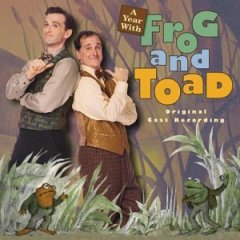 The kids and I went to our community children's theater production of A Year with Frog and Toad this afternoon. We adore the Frog and Toad series of early readers, written and illustrated by Arnold Lobel. Before the show there was a lot of speculation about which of the Frog and Toad stories we would be seeing; I'm pleased to report that many of our favorites (Spring; The Letter; The Garden; Cookies; The Surprise) made it in. The kids' favorite number was probably "Cookies," which came on just before the intermission. Coincidentally, I had packed a snack of cookies (no milk) which we ate right afterward. Thus fortified, we happily watched the second act of the show (in which Snail finally delivers the letter Frog sent to Toad in the first act). We liked it! Not as much as the books (of course), but enough to consider buying the soundtrack.
The kids and I went to our community children's theater production of A Year with Frog and Toad this afternoon. We adore the Frog and Toad series of early readers, written and illustrated by Arnold Lobel. Before the show there was a lot of speculation about which of the Frog and Toad stories we would be seeing; I'm pleased to report that many of our favorites (Spring; The Letter; The Garden; Cookies; The Surprise) made it in. The kids' favorite number was probably "Cookies," which came on just before the intermission. Coincidentally, I had packed a snack of cookies (no milk) which we ate right afterward. Thus fortified, we happily watched the second act of the show (in which Snail finally delivers the letter Frog sent to Toad in the first act). We liked it! Not as much as the books (of course), but enough to consider buying the soundtrack.
[Favorite Frog and Toad stories which did not make it into A Year With Frog and Toad: A Lost Button and A List. What are your favorites?]
Leo made up a new word today: franxious. It describes our dog when he knows we are about to go out in the car without him: frantic and anxious. It also describes me more often than I would like. I think this word will make it into the family lexicon along with inspectify (to examine something extra-closely) and, my favorite, supertomorrow (the day after tomorrow. I use this one all the time). Leo hopes it will take off like the word frindle did in Andrew Clements's middle-grade novel of the same name.
 Frindle is my favorite of Clements's many good school stories. We listened to the audiobook edition read by John Fleming (Listening Library, 2004) on a long drive last summer, and Leo bought a paperback copy to read for himself as soon as we got home. Both print and audio editions are highly recommended.
Frindle is my favorite of Clements's many good school stories. We listened to the audiobook edition read by John Fleming (Listening Library, 2004) on a long drive last summer, and Leo bought a paperback copy to read for himself as soon as we got home. Both print and audio editions are highly recommended.
KidsPost (7/22/08) has more audio book recommendations for families. I noticed that The View From Saturday has multiple (probably 4) readers, just in case you don't like one; and the book, by E.L. Konigsburg, won the Newbery in 1997.
Happy listening!
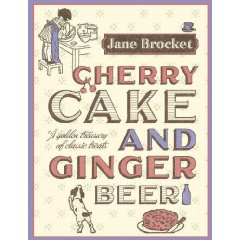 From the Guardian: Jane Brocket's Top Ten Food Scenes in Children's Literature. I like reading about what people are eating almost as much as I like reading their mail, and I recognized quite a few of Jane's favorites: Maria's tea, Marilla's raspberry cordial, Pippi's pancakes, and Paddington's elevenses. Jane's new book, Cherry Cake and Ginger Beer: A Golden Treasury of Classic Treats (Hodder and Stoughton, 2008) includes these and other recipes, each of which is introduced by "an evocative description of the book that inspired it" (from Jane's website). Yum. It's available now in the UK; I can't wait to get my hands on it.
From the Guardian: Jane Brocket's Top Ten Food Scenes in Children's Literature. I like reading about what people are eating almost as much as I like reading their mail, and I recognized quite a few of Jane's favorites: Maria's tea, Marilla's raspberry cordial, Pippi's pancakes, and Paddington's elevenses. Jane's new book, Cherry Cake and Ginger Beer: A Golden Treasury of Classic Treats (Hodder and Stoughton, 2008) includes these and other recipes, each of which is introduced by "an evocative description of the book that inspired it" (from Jane's website). Yum. It's available now in the UK; I can't wait to get my hands on it.
In the meantime, I would add opening Katy and Clover Carr's Christmas Box to my own list of favorite food scenes. It's from What Katy Did at School by Susan Coolidge (1873), and it begins like this:
Then [Katy] could wait no longer, but crept out of bed, crossed the floor on tiptoe, and raising the lid put in her hand. Something crumby and sugary met it, and when she drew it out, there, fitting on her finger like a ring, was a round cake with a hole in the middle of it.
"Oh, it's one of Debby's jumbles" she exclaimed.
Katy and Clover have to wait until after breakfast to unpack their box ("a big wooden one with all the nails taken out of the lid"), which is longer than I could have done. Here's a peek at what's inside:
The top of the box was mostly taken up with four square paper boxes, round which parcels of all shapes and sizes were wedged and fitted. The whole was a miracle of packing....
Each box held a different kind of cake. One was full, of jumbles, another of ginger-snaps, a third of crullers, and the fourth contained a big square loaf of frosted plum-cake, with a circle of sugar almonds set in the frosting. How the trio [Katy, Clover, and Rose Red] exclaimed at this!
And they haven't even gotten to their presents yet! No wonder that "'The Carrs' Box' was always quoted in the Nunnery afterwards, as an example of what papas and mammas could accomplish, when they were of the right sort, and really wanted to make schoolgirls happy."
What are your favorite food scenes in children's literature? I'll make a list with links to the books. Extra yum!
 If you haven't already, check out Jill Lepore's article "The Lion and the Mouse" in this week's New Yorker (Lives and Letters, 7/21/08). It's an account of NYPL children's librarian Anne Carroll Moore and E.B. and Katharine White's differences of opinion re: children's literature in general and Stuart Little (Harper, 1945) in particular.
If you haven't already, check out Jill Lepore's article "The Lion and the Mouse" in this week's New Yorker (Lives and Letters, 7/21/08). It's an account of NYPL children's librarian Anne Carroll Moore and E.B. and Katharine White's differences of opinion re: children's literature in general and Stuart Little (Harper, 1945) in particular.
For another perspective (the editor's) on Stuart Little, see Dear Genius: The Letters of Ursula Nordstrom (ed. Leonard S. Marcus; HarperCollins, 1998). I love reading other people's letters, and this is an interesting and insightful collection. Highly recommended.
Finally, I would have to re-read Stuart Little to give you my perspective on it; but I can say that while I'm fine with Stuart being a mouse, I don't like the invisible car.